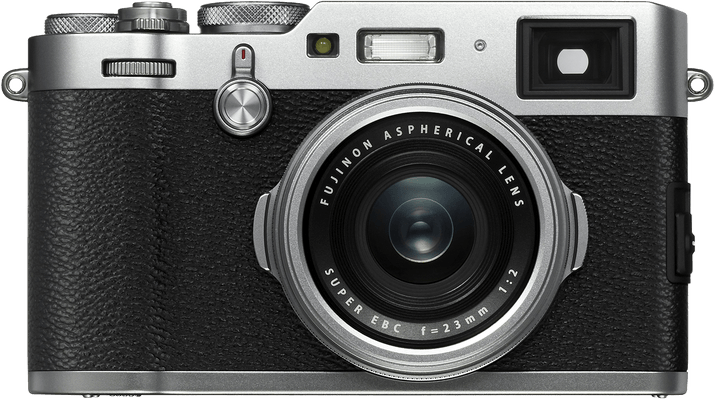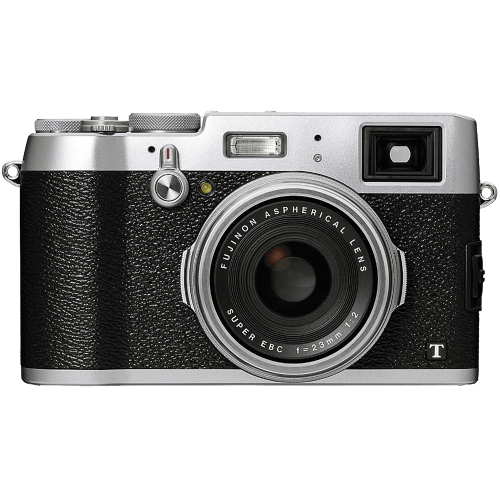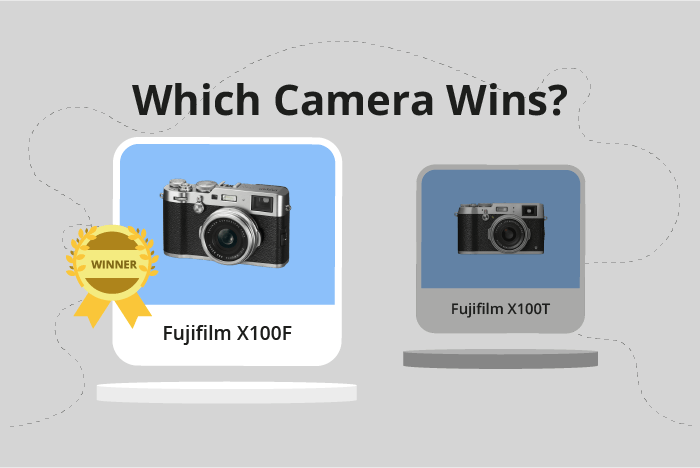Fujifilm X100F vs X100T Comparison
Fujifilm X100F

Fujifilm X100T

The Fujifilm X100F emerges as the winner with a score of 59/100, while the X100T trails behind at 53/100. Both cameras are mirrorless and share similar dimensions, with the X100F measuring 127 x 75 x 52mm and the X100T at 127 x 74 x 52mm. Additionally, they were launched at nearly the same price, with the X100F at $1299 and the X100T at $1300.
The X100F outshines its counterpart by being a newer model, released in 2017, compared to the X100T’s 2015 release. This gives the X100F an advantage in terms of updated features and improvements. However, the X100T has a slight edge in weight, being lighter at 440g, as opposed to the X100F’s 469g.
Taking everything into account, the Fujifilm X100F is the superior choice because of its higher score and updated features. Nevertheless, the X100T remains a viable option for those seeking a lighter camera.
Fujifilm X100F vs X100T Overview and Optics
The Fujifilm X100F outperforms the Fujifilm X100T in optics, scoring 64 out of 100 compared to the X100T’s score of 54. Both cameras share several optical specifications, including the CMOS sensor type, APS-C sensor size, fixed lens mount, and lack of image stabilization.
The X100F has a clear advantage with its 24-megapixel resolution, which provides more detailed and sharper images than the X100T’s 16-megapixel resolution. Additionally, the X100F offers a faster shooting speed of 8 frames per second (fps), allowing for better capture of fast-moving subjects compared to the X100T’s 6 fps. The X100F also benefits from an updated X-Processor Pro, which enhances image processing capabilities and overall performance compared to the X100T’s EXR Processor II.
While the X100T falls short in some aspects, it still has its merits. The 16-megapixel resolution may be lower than the X100F, but it can still produce quality images for casual photographers or those not requiring high-resolution prints. The 6 fps shooting speed, while not as fast as the X100F, is still sufficient for capturing most everyday situations.
Taking these factors into account, the Fujifilm X100F is the superior choice for those seeking better image quality and performance in optics. Its higher resolution, faster shooting speed, and improved processor contribute to its higher score and make it a more versatile camera for various photography needs. On the other hand, the Fujifilm X100T remains a viable option for casual photographers who do not require the advanced features and higher resolution offered by the X100F.
Fujifilm X100F vs X100T Video Performance
When comparing the video capabilities of the Fujifilm X100F and the Fujifilm X100T, both cameras have the same score of 70 out of 100. This means that they offer similar performance in terms of video recording. They share several video specifications, which include Full HD video resolution, maximum video dimensions of 1920 x 1080, a maximum video frame rate of 60fps, and built-in time-lapse functionality.
Since both cameras have identical scores and specifications, it is difficult to determine a clear winner in terms of video capabilities. However, there may be subtle differences in the quality of the video output, which could make one camera better than the other. It is essential to examine the actual video footage produced by each camera to make an informed decision.
On the other hand, there may be some advantages to using the Fujifilm X100T over the X100F, or vice versa, depending on the user’s specific needs and preferences. For example, the X100T might have a more intuitive interface or better ergonomics for video recording, while the X100F could offer more advanced video editing features or better compatibility with external accessories.
In order to determine which camera is best for video recording, it is crucial to consider factors beyond the specifications, such as user experience, ease of use, and compatibility with other equipment. This will help ensure that the chosen camera meets the individual needs of the user and provides the best possible results. Ultimately, both the Fujifilm X100F and X100T offer strong video capabilities, making them suitable choices for photographers who require high-quality video recording in addition to their still photography needs.
Fujifilm X100F vs X100T Features and Benefits
The Fujifilm X100T narrowly edges out the Fujifilm X100F with a feature score of 58/100 compared to the X100F’s 57/100. Both cameras share several specifications, including a 3-inch screen size, the absence of a touchscreen, a flip screen, no GPS, and the presence of WIFI and Bluetooth capabilities.
The X100T outperforms the X100F in screen resolution, boasting 2,360,000 dots compared to the X100F’s 1,040,000 dots. This higher resolution provides a sharper and clearer display, which enhances the overall user experience and makes it easier to review images and navigate menus.
On the other hand, the X100F does not offer any significant advantages over the X100T in terms of features. Both cameras have the same screen size, flip screen, lack of GPS, and connectivity options. The only difference in their feature scores is a single point, which does not indicate a clear winner in this category.
When comparing the Fujifilm X100F and X100T, the X100T holds a slight advantage in terms of features due to its superior screen resolution. However, the difference between the two cameras is minimal, and users may not notice a significant difference in the overall experience. The choice between the X100F and X100T ultimately depends on individual preferences and priorities, as both cameras offer a similar set of features and capabilities.
Fujifilm X100F vs X100T Storage and Battery
The Fujifilm X100F and X100T both have a storage and battery score of 21/100, showing no difference in this aspect. Both cameras feature a single memory card slot and accept SD, SDHC, and SDXC memory cards with UHS-I compatibility. Additionally, neither camera offers USB charging capabilities.
Despite having the same score, the X100F has a slight advantage in battery life, providing 390 shots compared to the X100T’s 330 shots. This is due to the X100F using a Lithium-Ion W126S battery, while the X100T uses a Lithium-Ion NP-95 battery. However, the X100T does not have any advantages over the X100F in terms of storage and battery.
Considering the commonalities and differences in storage and battery, the Fujifilm X100F is a marginally better choice due to its longer battery life. The Fujifilm X100T does not offer any improvements in this area, making the X100F the preferred option.
Fujifilm X100F vs X100T – Our Verdict
Are you still undecided about which camera is right for you? Have a look at these popular comparisons that feature the Fujifilm X100F or the Fujifilm X100T:

